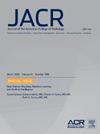综合介入放射住院医师中的女性代表:趋势、代表性不足和五年来的适度增长。
IF 4
3区 医学
Q1 RADIOLOGY, NUCLEAR MEDICINE & MEDICAL IMAGING
引用次数: 0
摘要
目的:自2014年介入放射学(IR)住院医师开始以来,女性仍然是少数受训人员。在其他外科专科也观察到类似的现象。我们的研究旨在量化从2018-19学年到2022-23学年的五年间综合IR中女性学员比例的变化,并与其他专业的趋势进行比较。方法:我们对从国家研究生医学教育数据库中收集的调查数据进行回顾性分析。包括IR在内的8个入选专业的选择,是由于与IR培训在质量上的相似性,或者是由于2018-19年度女性学员比例不到30%。在这个数据中,性别被分为男性和女性。收集研究期间各专业女性学员的百分比。采用方差分析、线性回归和Tukey HSD进行分析(P < 0.05)。结果:在五年的研究期间,女性在综合IR居住中的比例增长了16.6%,平均相对增长率为每年4.0%。到2022-23年,综合血管外科住院医师的女性学员比例最高(38.4%),而综合IR的比例第二低(22.4%),排在骨科(20.4%)之前。讨论:尽管观察到增长,女性实习生在综合IR中的比例落后于其他程序和放射学专业。我们的分析强调,有必要继续招聘女性求职者,以促进性别平等。支持已知的正在进行的计划,如女性导师计划,并制定新的战略来支持女性对IR的兴趣,应该是该领域的优先事项。本文章由计算机程序翻译,如有差异,请以英文原文为准。
Female Representation in Integrated Interventional Radiology Residency: Trends, Underrepresentation, and Modest Growth Over Five Years
Objective
Women remain a minority of trainees in interventional radiology (IR) since the residency’s inception in 2014. Similar phenomena have been observed in other surgical specialties. Our study aims to quantify changes in female trainee representation in integrated IR over a 5-year period from the 2018-2019 to 2022-2023 academic years and to compare with trends in other specialties.
Methods
We conducted a retrospective review of survey data collected from the National Graduate Medical Education database. The eight selected specialties, including IR, were chosen due to qualitative similarities with IR training or due to less than 30% female trainee representation in 2018-2019. In these data, gender was categorized as male or female. Percentage of female trainees in each specialty was collected in the study period. Analysis was conducted using analysis of variance, linear regression, and Tukey honest significant difference (P < .05).
Results
In the 5-year study period, female representation in integrated IR residency grew by 16.6% at a mean relative growth rate of 4.0% annually. By 2022-2023, integrated vascular surgery residency had the highest female trainee representation (38.4%), whereas integrated IR had the second lowest (22.4%), ahead of orthopedic surgery (20.4%).
Discussion
Despite observed growth, female trainee representation in integrated IR lags behind other procedural and radiology specialties. Our analysis emphasizes the need for continued recruitment of female applicants to bolster gender parity. Supporting known ongoing initiatives like female mentorship programs and developing new strategies to support female interest in IR should be a priority for the field.
求助全文
通过发布文献求助,成功后即可免费获取论文全文。
去求助
来源期刊

Journal of the American College of Radiology
RADIOLOGY, NUCLEAR MEDICINE & MEDICAL IMAGING-
CiteScore
6.30
自引率
8.90%
发文量
312
审稿时长
34 days
期刊介绍:
The official journal of the American College of Radiology, JACR informs its readers of timely, pertinent, and important topics affecting the practice of diagnostic radiologists, interventional radiologists, medical physicists, and radiation oncologists. In so doing, JACR improves their practices and helps optimize their role in the health care system. By providing a forum for informative, well-written articles on health policy, clinical practice, practice management, data science, and education, JACR engages readers in a dialogue that ultimately benefits patient care.
 求助内容:
求助内容: 应助结果提醒方式:
应助结果提醒方式:


